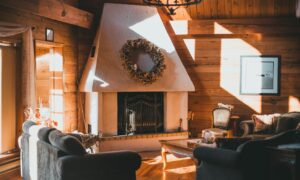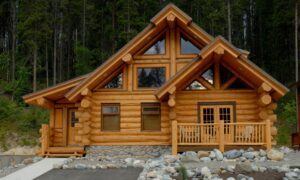Here’s What You’ll Learn in This Article
Discover how to maintain your log home year-round with a practical maintenance calendar. Learn monthly, seasonal, and yearly upkeep tips to protect your home from moisture, insects, and UV damage. Explore expert advice from Caribou Log Homes to extend your cabin’s life and preserve its natural beauty for generations.
Introduction
Owning a log home is a dream come true for many—a blend of natural beauty, warmth, and timeless craftsmanship. However, maintaining that charm takes consistent effort and planning. A well-structured log home maintenance calendar ensures your cabin stays strong, weather-resistant, and beautiful for generations to come.
At Caribou Log Homes, we understand that every log home is an investment that deserves proper care. From monthly checks to annual upkeep, maintaining a schedule helps prevent costly repairs and keeps your home in peak condition throughout the year. This comprehensive guide will help you set up a realistic maintenance calendar—backed by expert insights, practical tips, and the latest industry best practices.
Why a Log Home Maintenance Calendar Matters
Unlike conventional homes, log homes are organic structures made from living material—wood. That means they naturally expand, contract, and respond to changes in moisture, sunlight, and temperature.
Without consistent attention, small issues like gaps, moisture intrusion, or fading finishes can quickly become serious structural or cosmetic problems.
Stat: According to the Log Homes Council, regular maintenance can extend a log home’s lifespan by 50% or more compared to neglected properties.
Source: Log Homes Council, NAHB
Creating a log home maintenance calendar helps you:
- Stay proactive instead of reactive
- Protect your investment from rot, insects, and UV damage
- Keep your home energy-efficient and visually appealing
Monthly Log Home Maintenance Tasks
Routine monthly inspections help you catch issues early. While you don’t need to do a full-scale inspection every month, certain simple checks can make a big difference over time.
1. Check for Moisture and Leaks
Moisture is the number one enemy of log homes. Walk around your home’s exterior monthly and inspect for signs of dampness, dark spots, or mold growth.
Pay special attention to:
- Areas under eaves and windows
- Log corners and foundation joints
- Roof valleys and gutters
Tip: Use a moisture meter to monitor log humidity. Readings above 20% may indicate water infiltration.
2. Clean Gutters and Downspouts
Leaves and debris can block gutters, causing water to overflow and damage your logs. Keep them clean, especially after storms.
3. Inspect Interior for Drafts
Feel for cold air near windows, doors, and corners. Drafts may mean sealant failure or minor settling. Early detection prevents heating inefficiencies.
4. Monitor HVAC Filters and Ventilation
Replace air filters monthly to maintain air quality. A well-ventilated home prevents humidity buildup that can affect log integrity.
5. Wipe Down Interior Logs
Dust and light dirt accumulation on interior log walls can trap moisture. Use a damp cloth (not wet) to clean surfaces gently.
Seasonal Maintenance Tasks
While monthly checks keep your home in check, each season brings unique challenges. Planning seasonal inspections ensures that you’re prepared year-round.
Spring: The Renewal Season
After winter’s freeze-thaw cycle, spring is a critical time for assessment.
- Inspect for winter damage: Look for cracked chinking, loose caulking, or lifted finishes.
- Power wash exterior walls: Use a mild log cleaner and low pressure to remove dirt and mildew.
- Trim nearby vegetation: Maintain at least a 3-foot gap between foliage and logs for airflow.
- Re-treat decks and railings: Use a quality wood preservative to protect from UV rays.
According to Log Home Living magazine, spring is the best time to schedule professional inspections for log stain performance and UV damage.
Summer: The Protection Season
Summer is ideal for applying stains and sealants because of dry weather conditions.
- Inspect and repair chinking or caulking where gaps have formed.
- Re-stain exterior surfaces if you notice fading or water no longer beads up.
- Check roof shingles and flashing for damage caused by spring storms.
- Inspect your pest control systems. This is peak season for carpenter bees and termites.
Stat: The USDA Forest Service reports that regular pest control maintenance reduces insect-related log damage by up to 80%.
Source: USDA Forest Products Laboratory
Fall: The Preparation Season
Fall is all about preparing your log home for the winter ahead.
- Clean gutters again to remove fallen leaves.
- Inspect insulation and weatherstripping around doors and windows.
- Check chimney and fireplace. Have them cleaned professionally to prevent soot buildup.
- Touch up exterior finishes where wear is visible.
Winter: The Monitoring Season
Winter is a quieter maintenance period but still crucial.
- Inspect attic and crawl spaces for condensation or ice dams.
- Check for snow buildup on roofs and decks—heavy snow can stress log structures.
- Maintain indoor humidity levels around 35–45% to prevent log shrinkage.
- Monitor for ice dams. These can lead to water infiltration if ignored.
Yearly Log Home Maintenance Checklist
An annual deep inspection is your best defense against long-term issues. Schedule it during late spring or early fall when conditions are mild.
1. Inspect Stains and Finishes
Your exterior stain is your home’s first line of defense. Check if water still beads up on log surfaces. If not, it’s time to reapply.
Tip: Use a high-quality stain from trusted brands like Sashco or Perma-Chink Systems. According to Perma-Chink’s maintenance guide, most stains should be refreshed every 3–5 years for optimal protection.
2. Check Chinking and Sealants
Inspect joints, corners, and log intersections for gaps. Replace deteriorated sealant promptly to prevent air and water leaks.
3. Examine Roof and Gutters
Ensure shingles, flashing, and vents are secure. Clear any remaining debris from gutters and downspouts.
4. Inspect Foundation and Drainage
Confirm that the ground slopes away from your foundation to prevent water pooling. Foundation cracks or erosion should be addressed immediately.
5. Assess Insect and Rodent Control
Termites, ants, and carpenter bees are ongoing threats. Partner with a licensed pest control specialist for yearly treatment.
6. Evaluate Decks, Railings, and Porches
Apply protective finishes annually to decks, especially in high-sun or high-rain regions.
7. Schedule a Professional Inspection
While homeowners can handle basic checks, a professional log home inspector can identify hidden issues. According to Log Cabin Homes Magazine, annual inspections can save homeowners thousands in long-term repair costs.
Long-Term Maintenance Goals
A well-maintained log home can last over a century. To make that happen, combine daily awareness with structured upkeep.
- Every 3–5 years: Full stain and sealant reapplication
- Every 10 years: Deep clean, inspect roof and windows for replacement needs
- Every 15–20 years: Reassess insulation and structural integrity
At Caribou Log Homes, we recommend creating a personalized maintenance binder. Log every inspection date, product used, and service performed—it becomes your home’s history book and a great resource for future owners.
Expert Tips for Stress-Free Maintenance
Pro Tip 1: Schedule your inspections seasonally on the same dates each year to build a maintenance routine.
Pro Tip 2: Use natural-based cleaners and stains to protect your logs and the environment.
Pro Tip 3: Invest in good overhangs and gutters to reduce water exposure.
Pro Tip 4: Maintain good airflow under decks and crawl spaces to prevent rot.
According to the International Log Builders Association (ILBA), preventive maintenance can reduce total repair costs by up to 60% over the lifespan of your log home.
Final Thoughts
Your log home is more than a structure—it’s a legacy. A thoughtful log home maintenance calendar not only protects your investment but also enhances its natural beauty and comfort for decades to come.
At Caribou Log Homes, we don’t just build handcrafted log homes—we build enduring lifestyles rooted in nature, quality, and care. With regular maintenance, your log home will continue to stand tall as a symbol of craftsmanship and serenity.
Whether you’re planning to build, renovate, or maintain your log home, our experts are always here to guide you with professional insights and trusted solutions.
FAQs
1. How often should I inspect the exterior of my log home?
A light inspection should be done monthly, but a thorough check is recommended every spring and fall.
2. When should I re-stain my log home?
Typically, every 3–5 years, depending on your climate and the quality of the product used.
3. What’s the best way to prevent insect damage?
Regular pest control treatments, sealing gaps, and maintaining dry conditions around your logs are key.
4. How can I tell if my log home has moisture problems?
Look for dark patches, peeling stain, or musty odors. A moisture meter can help confirm internal humidity levels.
5. Can I do all log maintenance myself?
Basic cleaning and inspection are DIY-friendly, but professional inspections and staining ensure long-term protection and warranty validity.





